Yesterday I gave an overview of the Thinkering Spaces project, so today I want to explain a little more about how we were able to manipulate content using the various technologies and objects.
 RFID is a big component of the system, as it identifies content and allows it to travel with an object. To start, the TS folks put a book with an RFID chip on the reader, which triggers a process that displays the cover on the screen, along with a keyboard for typing text to associate with the title. In this case, the container is the book, and the user can draw or type to add content that will travel with it. To illustrate this, they remove the first book and put a second one on the reader. A new cover image appears, along with some information that’s already been added by a previous user. Take that book off and put the first one back on, and the content we added reappears. The whole thing is very cool, and I immediately started thinking about local history collections, schoolwork, and reader reviews. All of which is the point - your librarian mind starts hopping with possibilities.
RFID is a big component of the system, as it identifies content and allows it to travel with an object. To start, the TS folks put a book with an RFID chip on the reader, which triggers a process that displays the cover on the screen, along with a keyboard for typing text to associate with the title. In this case, the container is the book, and the user can draw or type to add content that will travel with it. To illustrate this, they remove the first book and put a second one on the reader. A new cover image appears, along with some information that’s already been added by a previous user. Take that book off and put the first one back on, and the content we added reappears. The whole thing is very cool, and I immediately started thinking about local history collections, schoolwork, and reader reviews. All of which is the point - your librarian mind starts hopping with possibilities.
Then they showed us a library card with an RFID chip in it. This one happened to have information about me stored on it, so putting it on the reader brought up information about me, which rotated with books I recommend. Others in the Thinkering Space could see all of this about me, which would be great if I was working with a group I’m mentoring, coordinating, or collaborating with. The IIT folks understand the privacy issues involved, though, so they’re exploring different ways to handle this. Alternatives include using avatars without personally identifiable information, having the group build a persona to achieve certain skills, and using special cards for collaborative clubs rather than embedding the information in standard library cards (this would provide an opt-in system). None of this is set in stone, but it demonstrates one way in which library users might share information about themselves in the physical library.
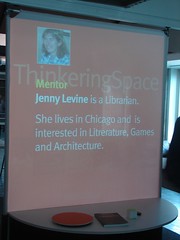
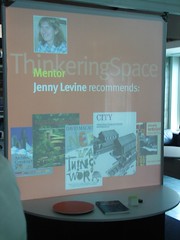
Next, we began playing with the story of The Wizard of Oz by placing a Rubik’s Cube with RFID chips on it on a reader. The starter Oz content is attached to this container and it can include the text and images from the book itself. Placing a second, blank, paper “storycube” on the reader brings up a template where someone can use a wand to drag and drop images into a template to tell a story, which can then be saved to another object (in this case, it was a small doll). Putting a second doll on the reader brought up someone else’s story. The container could be anything that uses RFID or barcodes. Turning the cube produces other content, such as weather maps (watch for tornadoes), and putting a camera on the reader brings up pictures and images related to the book, all of which can be manipulated on the screen.
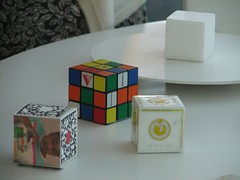

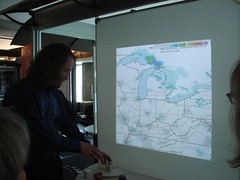
TJ then took some pictures of the group and other objects in the space, and since his digital camera had an Eye-Fi card in it, the pictures began appearing on the screen as well. We could then mash up these pictures with text, sounds, and other digital content to create a narrative, a presentation, a document, or just explore them all together. The space also has a digital microscope and a webcam that can project images onto the screen as well.
We also played with a collaborative drawing table that just does a basic coloring demo right now. However, the idea is that there might be some projects where users can work on their own pieces separately to build a larger whole, or they may have to collaborate and work together as a team to create something. Sometimes they might have their head down working, but other times they might have their head up, interacting with the other participants. Pretty much everything in the space is based on collaboration, as opposed to single users.
What I like about these ideas is that they expand on existing content in the library, using the library’s collection, and mashing it up with users’ ideas to create something new. It’s Jon Udell’s remixed physical library, not just the online one. Or the users create something new from the beginning, based on their interactions with our collections and services. The community can contribute content and knowledge, and the library could archive it.
And it doesn’t have to be just for kids or students. For seniors who have trouble using a mouse and a computer, a setup that lets them use a wand (or even better, their fingers) to drag objects might allow them to play with digital content (especially local history) in different ways. Could families create genealogical histories this way and mash them up with community resources? The Shanachies in the Netherlands intend to build a giant screen in the DOK Library Concept Center where residents can post their own stories and pictures. Imagine combining that with library cards that let those residents update their stories and remix them in a Thinkering Space.
It will be interesting to see what happens to things like narrative and copyright in these types of environments. One of the questions now is will libraries be one of them? This project gives me hope that the answer is yes, and honestly, what better institution do we have in which to discuss, explore, and implement the answers?
collaboration,
iit,
illinois institute of technology,
institute of design,
jon udell,
libraries,
macarthur foundation,
remixed library,
thinkering spaces
Today I saw one possible future for libraries, and it has me pretty excited. I can look back on my professional career and see a progression of advocating for shifting services to where our users are, making our spaces more collaborative, and reinvigorating libraries as the community center (regardless of type of library). It’s why I’ve explored technology, blogging, RSS, social networks, gaming, and collaborative spaces. Today, many of those pieces came together for me in a pretty amazing package that has the power to reimagine the library as third place, cross some digital divides, and integrate participatory culture into our service model. Even better, it involves people and books, not just technology.
 So what did I see today? A project called Thinkering Spaces, conceived of by some very smart people at the Illinois Institute of Technology’s Institute of Design and funded by the MacArthur Foundation. After quite a bit of initial visioning and research, this group has built a prototype for a relatively cheap, portable, collaborative space that can be put up and taken down in libraries of any size on the fly. It’s built using an out-of-the-catalog Steelcase frame, and uses Johnny Lee Chung’s Nintedo wiimote hacks to create an inexpensive, drag-and-drop environment. The technology is as plug and play as it can be to create an open source, open content space where any future technology that is built on these standards can be easily integrated.
So what did I see today? A project called Thinkering Spaces, conceived of by some very smart people at the Illinois Institute of Technology’s Institute of Design and funded by the MacArthur Foundation. After quite a bit of initial visioning and research, this group has built a prototype for a relatively cheap, portable, collaborative space that can be put up and taken down in libraries of any size on the fly. It’s built using an out-of-the-catalog Steelcase frame, and uses Johnny Lee Chung’s Nintedo wiimote hacks to create an inexpensive, drag-and-drop environment. The technology is as plug and play as it can be to create an open source, open content space where any future technology that is built on these standards can be easily integrated.
The point is to bring spaces into libraries that let people collaborate around the content that already exists in in our buildings, add new content to the mix, mash it all up to create something new, and share it with the community. Rinse. Repeat. It’s a way to connect people with the physical world and help them make sense of it by interacting with and changing it. It’s another instance where the library adds value to the equation (the same way it does with books and now games), offering an experience you can’t replicate at home, borne of the community. TJ, the programming wizard behind the curtain, called it a “human interface environment,” rather than a “human computer interaction.” It takes the focus off technology and puts it back onto the people.
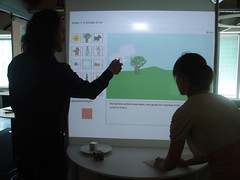 The various pieces are designed for different types of interactions, including:
The various pieces are designed for different types of interactions, including:
- asynchronous
- synchronous
- subscribe to a mentor (one-to-many)
- collaborative storytelling/joint commentary
- cumulative experience (see what others have done and build on it or change it)
Because the space is scalable down to 5′x5′ or expandable up to 12′x12′, it should fit in most buildings in some form. Libraries could assemble the full version one day and only certain pieces the next week. It could be used at specific times for certain programming and then broken down and stored until the next session. It has its own contained wireless network, or it could access the library’s wifi. It’s designed to create a distinct, exploratory environment that doesn’t require anyone to run it.
 Out of all of the discussions and demonstrations today, TJ summed it up best when he said the project is about ” ‘look at what I did,’ as opposed to ‘look at what I bought.’ ” To provide that type of interaction in the safe, non-commercialized third place of the library for the entire community is a pretty exciting prospect. No other entity in the community could provide the breadth and depth of this type of experience. The team at IIT - Dale Fahnstrom, Greg Prygrocki, Heloisa Moura, and TJ - has created a working prototype that dazzles the imagination for the next generation of library services.
Out of all of the discussions and demonstrations today, TJ summed it up best when he said the project is about ” ‘look at what I did,’ as opposed to ‘look at what I bought.’ ” To provide that type of interaction in the safe, non-commercialized third place of the library for the entire community is a pretty exciting prospect. No other entity in the community could provide the breadth and depth of this type of experience. The team at IIT - Dale Fahnstrom, Greg Prygrocki, Heloisa Moura, and TJ - has created a working prototype that dazzles the imagination for the next generation of library services.
Over the next few days, I’ll write more about the details, the plan, and what I hope is the future of the project, but for now you can see my Flickr set of pictures from today’s visit to get an idea of what it looks like and what it can do. Keeping in mind that it’s still in the prototype phase, it’s still pretty inspiring.
collaborative spaces,
illinois institute of technology,
institute of design,
libraries,
macarthur foundation,
thinkering spaces,
third place
 According to the website ReadingSuccessLab.com, Government statistics show 25 million Americans are functionally illiterate. The primary cause is dyslexia or one of its many variants.
According to the website ReadingSuccessLab.com, Government statistics show 25 million Americans are functionally illiterate. The primary cause is dyslexia or one of its many variants.
Through their children’s book series, Hank Zipzer: The World’s Greatest Underachiever, co-authors Lin Oliver and Henry Winkler share the struggles and triumphs of a resourceful elementary school student as he deals with the challenges that come with dyslexia. The stories are based on Henry Winkler’s own experiences with the disorder.
On this edition of Just One More Book, Mark speaks with actor, director, producer and author, Henry Winkler about becoming an author and his relationship with Hank Zipzer, his struggles with reading and learning, and what we can do to help our children.
Links to Hank Zipzer books:
This is episode 300 of Just One More Book!!
UPDATE: Click here to see the transcript of this interview.
Photo: American Library Association
Tags:
childrens books,
dyslexia,
Hank Zipzer,
Henry Winkler,
interview,
Lin Oliverchildrens books,
dyslexia,
Hank Zipzer,
Henry Winkler,
interview,
Lin Oliver
You guys are writing in faster than I can post! This is great!!! Here's the latest from cyber kid 303:
I have not read all the Harry Potter books. I am in the middle of the third one, Prisoner of Azkaban. I have seen all the movies and I think the best is a tie between Harry Potter and the Sorcorer's Stone and Harry Potter and the Goblet of Fire. The movies are really cool with the animations and special effects, but the books are better with more things going on. So far, I like the book Prisoner of Azkaban best.
I heard Darth Bill is sick and can't do the Beowulf program. I'm sorry he is sick.
Here are some books I really like.
Goosebumps books by R. L. Stine
American Chillers books by Jonathan Rand
Rotten School books by R. L. Stine
Captain Underpants books by Dav Pilkey
The Fudge series by Judy Blume
Judy Moody books by Megan McDonald
Hank Zipzer books by Henry Winkler
Choose Your Own Adventure series by R.A. Montgomery and Shannon Gilliganand
the Matt Christopher series by Matt Christopher.
I'm glad you like the Matt Christopher books. I like them too. I've never read the Fudge or the Hank Zipzer books, though, and you've made me curious.
Whew! Hard work keeping up with you all. Keep it up!!!
Carl
 RFID is a big component of the system, as it identifies content and allows it to travel with an object. To start, the TS folks put a book with an RFID chip on the reader, which triggers a process that displays the cover on the screen, along with a keyboard for typing text to associate with the title. In this case, the container is the book, and the user can draw or type to add content that will travel with it. To illustrate this, they remove the first book and put a second one on the reader. A new cover image appears, along with some information that’s already been added by a previous user. Take that book off and put the first one back on, and the content we added reappears. The whole thing is very cool, and I immediately started thinking about local history collections, schoolwork, and reader reviews. All of which is the point - your librarian mind starts hopping with possibilities.
RFID is a big component of the system, as it identifies content and allows it to travel with an object. To start, the TS folks put a book with an RFID chip on the reader, which triggers a process that displays the cover on the screen, along with a keyboard for typing text to associate with the title. In this case, the container is the book, and the user can draw or type to add content that will travel with it. To illustrate this, they remove the first book and put a second one on the reader. A new cover image appears, along with some information that’s already been added by a previous user. Take that book off and put the first one back on, and the content we added reappears. The whole thing is very cool, and I immediately started thinking about local history collections, schoolwork, and reader reviews. All of which is the point - your librarian mind starts hopping with possibilities.










